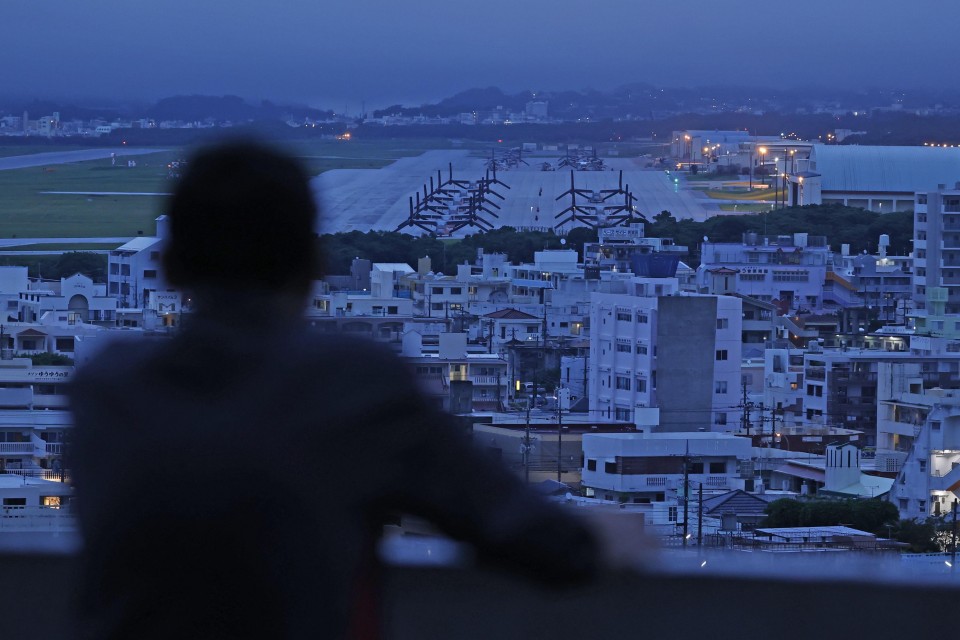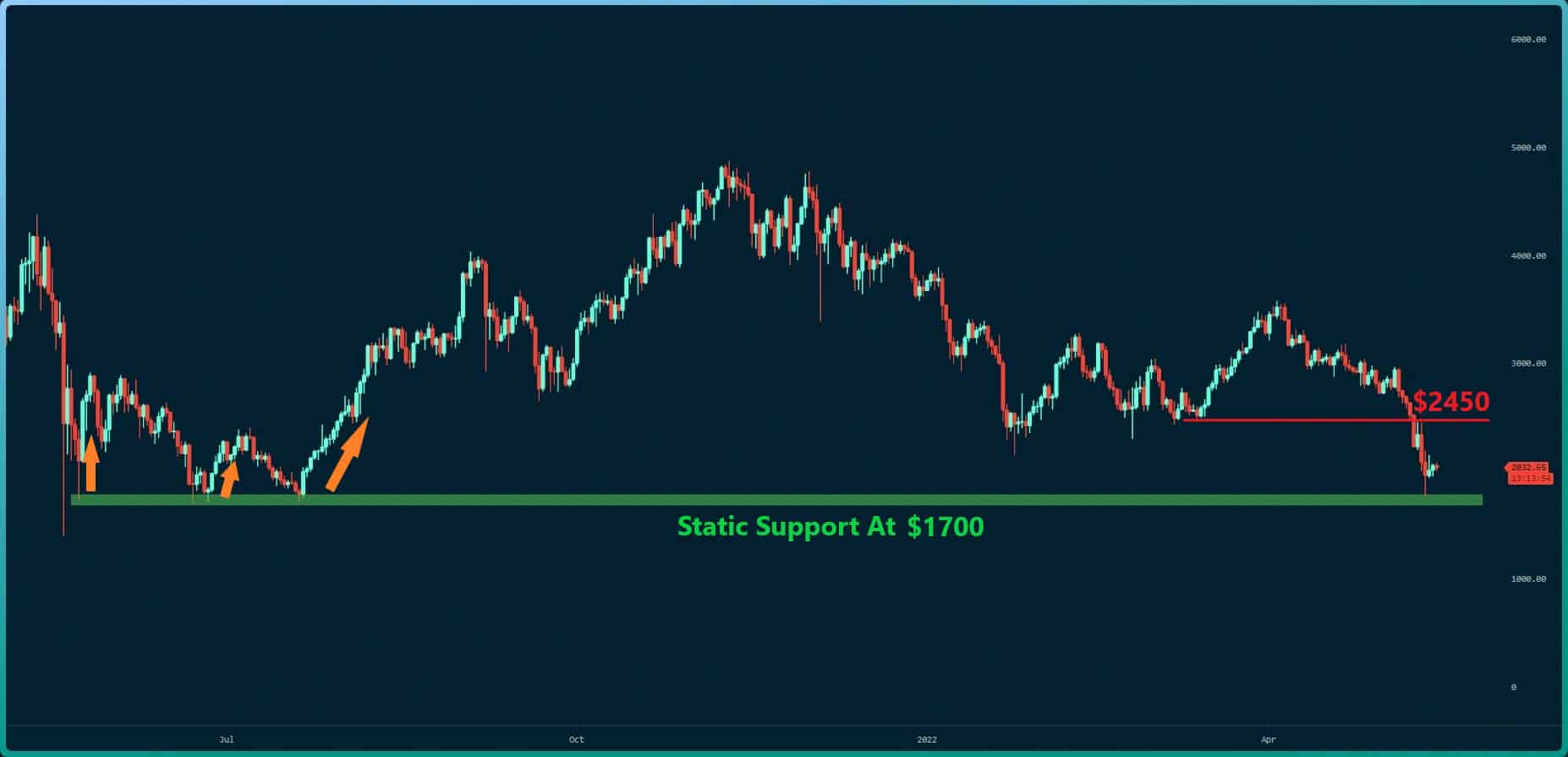[ad_1]
The southern island prefecture of Okinawa on Sunday marked 50 years since its reversion to Japan from U.S. rule as residents’ frustrations continue over a weak local economy and the ongoing presence of U.S. military bases despite decades of protest.
At a commemoration ceremony held near a major U.S. military base on the island, Gov. Denny Tamaki urged the central government to undertake “sincere efforts” to make Okinawa “an island of peace,” saying that mutual goal made at the time of reversion remains unfulfilled.

Japanese Emperor Naruhito (seen on screen) virtually attends a ceremony being held in the Okinawa Prefecture city of Ginowan on May 15, 2022, to mark the 50th anniversary of the southern prefecture’s reversion to Japan from U.S. rule. (Kyodo) ==Kyodo
Related coverage:
Q&A: Okinawa on 50th anniversary of reversion from U.S. rule

Japanese Prime Minister Fumio Kishida makes a speech during a ceremony marking the 50th anniversary of Okinawa Prefecture’s reversion to Japan from U.S. rule in the southern prefecture’s city of Ginowan on May 15, 2022. (Kyodo) ==Kyodo
“Even after 50 years…the people of Okinawa continue to be forced to shoulder excessive base-hosting burdens,” Tamaki said in his speech, citing accidents and crimes involving U.S. troops as some glaring examples.
“We hope the government will make sincere efforts to create a peaceful and prosperous Okinawa where every resident can feel happy in the true sense.”
In his remarks at the event, Prime Minister Fumio Kishida acknowledged the continuing “large base-hosting burden” on Okinawa and pledged to “steadily make visible progress on the alleviation of the burden while maintaining the deterrence offered by the Japan-U.S. alliance.”
On Okinawa’s economic fragility, with its per capita income remaining the lowest in Japan, Kishida said the government will work to “unlock Okinawa’s potential to the maximum” and realize “a strong Okinawan economy.”
The ceremony was held at a convention center near U.S. Marine Corps Air Station Futenma in Ginowan, whose proximity to a densely populated area has made it a symbol of the burden long borne by Okinawans.
Okinawa was returned to Japan on May 15, 1972, 20 years after the country restored its sovereignty following its defeat in World War II. While under U.S. administration, granted by the 1951 San Francisco Peace Treaty, acres of land were expropriated and turned into military bases.
Even half a century after its reversion, Okinawa continues to host the bulk of U.S. bases in the country, despite its stated hope of becoming “a peaceful island free of military bases” upon its return to Japanese rule.
The ceremony was also held in Tokyo, with the two venues connected via video link and drawing a total of around 1,300 people. Emperor Naruhito and Empress Masako appeared remotely.
In his remarks, the emperor expressed sympathy for the people of Okinawa over the devastation they suffered during the war and the difficulties they continue to face.
“I hope a broader section of Japanese, including the young generation, will further deepen their understanding of Okinawa,” the emperor said, wishing a prosperous future for the prefecture.

A man looks at U.S. Marine Corps Air Station Futenma (background) in Ginowan, Okinawa Prefecture, on May 15, 2022, the 50th anniversary of the southern island prefecture’s reversion to Japan from U.S. rule. (Kyodo) ==Kyodo
President Joe Biden had a personal message for the people of Okinawa. The U.S. leader looks “forward to further deepening our friendship across Japan and to contributing to Okinawa’s prosperity with an eye to the next 50 years,” Ambassador to Japan Rahm Emanuel said at the Tokyo venue.
The ambassador also announced a language scholarship program for high school students in Okinawa, saying his recent meeting with Okinawan students has taught him that “the alliance isn’t about a treaty alone but a friendship between people.”

Okinawa Gov. Denny Tamaki makes a speech during a ceremony marking the 50th anniversary of the southern prefecture’s reversion to Japan from U.S. rule in Ginowan on May 15, 2022. (Kyodo) ==Kyodo
Representing Okinawa’s youth, 20-year-old Miyabi Heshiki also spoke at the ceremony and expressed her generation’s resolve. “We will protect and build on what our ancestors have built so we can make a better future for Okinawa.”
Meanwhile, about 80 people gathered outside the Okinawa venue to show their opposition to the ceremony. Hiroshi Kawagoshi, a 76-year-old organizer, said, “We have been deprived of rights as Uchinanchu (Okinawans) for the past 50 years. We want to say this is not a happy day.”
Earlier Sunday, Kishida, sporting a traditional Okinawan “kariyushi” short-sleeve shirt, surveyed the Futenma base from the top of the nearby city hall in his first stop there as prime minister.
Then, during a visit to Marines’ Camp Foster just to the north, he unveiled plans to start using some of the base jointly with the United States before the scheduled return of the plot to Japanese control.
A rally was also held in the prefectural capital of Naha in the morning, with participants calling for all military bases to be removed from Okinawa.
The prefecture hosts 70.3 percent of U.S. military installations in Japan by acreage, up from 58.8 percent in 1972. The bilateral security treaty allows the United States to keep bases on Japanese soil.
With Okinawa being the site of the biggest ground battle on Japanese soil during World War II that cost an estimated 200,000 lives, half of them civilians, antipathy toward U.S. bases remains strong.
Such a feeling has been exacerbated by constant noise from military aircraft and drills. Plane crashes and environmental pollution on top of rapes and murders committed by U.S. service members have also added to the discontent.
According to a Kyodo News survey conducted among 1,500 residents aged 18 or older across Okinawa from March to April, 55 percent said they have been dissatisfied with the course of history after Okinawa’s return to Japan, while 94 percent welcomed the reversion itself.
The survey also showed that 58 percent want a significant reduction in U.S. military facilities on the island, while 26 percent were fine with the status quo. Only 14 percent preferred their total removal.

People walk in the village of Kitanakagusuku toward the U.S. Kadena Air Base in Okinawa Prefecture, southern Japan, on May 14, 2022, during a peace march calling for the burden on Okinawa from hosting U.S. forces to be reduced, a day before the 50th anniversary of its reversion to Japan. (Kyodo) ==Kyodo
Repeated calls to alleviate the burden of hosting the bases had long been overlooked by the central government, which has emphasized the strategic importance of Okinawa due to its proximity to potential flashpoints such as Taiwan in the face of an expanding Chinese military presence.
The central government also claims that the presence of U.S. forces on the island serves an important role in the security of Japan. Still, some residents fear that could also get the island involved in wars as geopolitical tensions mount over Russia’s invasion of Ukraine and China’s territorial ambitions.
“We can never tolerate a situation where Okinawa becomes a target of attack because of U.S. military bases,” Tamaki told reporters after the ceremony.
Competing desires between the Japanese government and the Okinawa people have led to the stalled relocation of the Futenma base. While the central government is determined to build a replacement facility in a less populated coastal area of Okinawa, many Okinawans demand the base be relocated outside the island prefecture.
The Futenma relocation plan dates back to a 1996 Japan-U.S. deal on returning the land used for the Marine airfield, which was struck amid public outrage over the 1995 gang rape of a 12-year-old schoolgirl in Okinawa by three U.S. servicemen.
While the island has enjoyed some degree of economic growth over the past 50 years, it still lags behind the rest of Japan economically. Many blame it partly on Okinawa being left under U.S. rule for years while the rest of the country enjoyed decades of high postwar growth during the “economic miracle” period.
Okinawa has continually ranked the lowest among the country’s 47 prefectures in average income per capita due to a lack of strong industries aside from tourism in some parts of the prefecture, leading to a wide income gap among residents.
Single mothers and child poverty are also common on the island, with a higher unemployment rate than in most parts of the country.
While a number of residents work on U.S. bases, Tamaki has dismissed the view that Okinawa is dependent on the bases economically, saying base-related jobs generate only 5 percent of residents’ total income, an improvement from around 15 percent at the time of the reversion.
Making use of the land currently dedicated to U.S. bases but slated for return to the prefecture, the governor says it can create an economic impact of 900 billion yen ($6.9 billion), more than triple the current U.S. base-related income in the prefecture, as well as 80,000 jobs, about nine times the number of Japanese workers on the bases.
After the ceremony, Tamaki handed Kishida the prefecture’s recently compiled economic development plan for the next 10 years and sought the central government’s cooperation.
“We will actively propel promotion measures for Okinawa’s economy as one of our national strategies so its economy can become self-sufficient,” the prime minister replied.
Chronology of main events related to Okinawa
December 1941 — Japan attacks Pearl Harbor in Hawaii, the United States enters war with Japan.
March 26, 1945 — U.S. troops land on Kerama Islands, near Okinawa’s main island, Battle of Okinawa begins.
June 23 — Japanese military stops organized fighting in Okinawa.
Aug. 15 — Japan surrenders to the Allied forces.
Sept. 2 — Japan signs surrender papers.
April 28, 1952 — Japan regains sovereignty as San Francisco Peace Treaty takes effect, but Okinawa and other remote islands remain under U.S. control. Japan-U.S. security treaty takes effect.
December 1953 — Amami Islands near Okinawa return to Japanese rule.
1956 — Local protests erupt over land expropriation by U.S. military.
June 30, 1959 — U.S. fighter jet crashes into elementary school in what is now Uruma, Okinawa, leaving scores of people dead or injured.
June 1968 — Ogasawara Islands return to Japanese rule.
Nov. 19 — U.S. B-52 bomber crashes at Kadena Air Base.
November 1969 — Japan, U.S. leaders announce Okinawa reversion in 1972.
Dec. 20, 1970 — Rioting occurs in what was then Koza, outside Kadena base, after local man hit by U.S. serviceman’s car.
May 15, 1972 — Japan regains control of Okinawa.
September 1995 — Local schoolgirl abducted and raped by U.S. servicemen, prompts fierce protests among Okinawa people.
April 1996 — Japan, U.S. agree to reversion of Marine Corps Air Station Futenma to Japanese control.
Aug. 13, 2004 — Large U.S. transport helicopter crashes into Okinawa International University, just outside Futenma airfield.
December 2018 — Japan begins reclaiming waters off Okinawa coast to build Futenma replacement facility.
May 15, 2022 — Okinawa marks 50 years since reversion.

[ad_2]
Source link




















